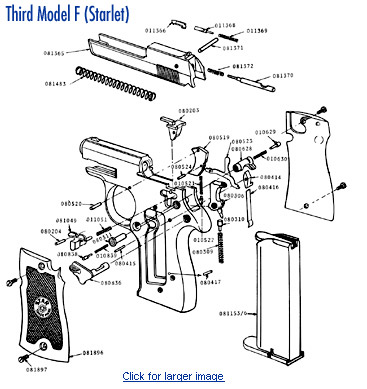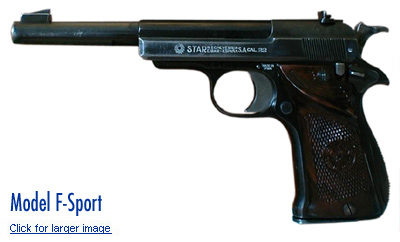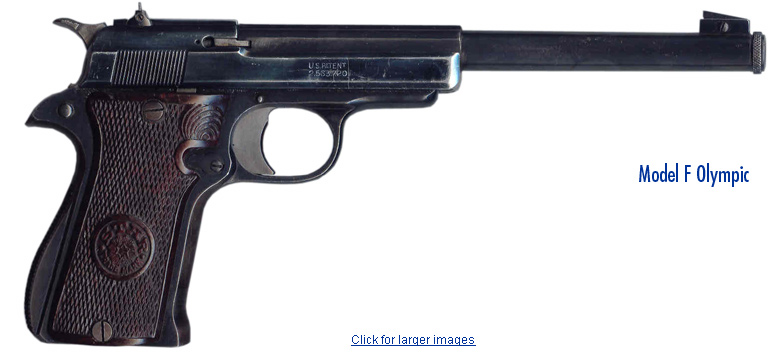Star Firearms — F-series pistols
The F series is the .22 Long Rifle caliber general purpose target pistol variant of the classic Star pocket pistols. Its first appearance was in 1932, concurrent with the similar-sized I-series .32 pocket pistols; both of these are the largest of the lineage. The E-series continued the line with an ultra-compact .25 ACP (6.35 mm) in 1925, and the larger .25 ACP C-series series first appeared in 1930. All these pistols are generally similar in arrangement and scale, with a fixed barrel, straight blowback operation, and single-action lockwork. All have a thumb-operated safety just behind the trigger on the left side of the frame, and the takedown button is to the rear of this, in a notch in the top of the grip panels (note that some series moved to a conventional thumb safety later in life).
The model F was itself made in a number of variants, most of which are configured for target purposes, with precision sights and larger barrels. Over the years there have been four basic series, each of which is covered in sequence below.
Model Fs are usually easy to identify. They are often encountered in very good shape, and very frequently with their original boxes and other paperwork. In addition to the usual methods of identification most of the model F series guns seem to have "US Patent 2,563,720" on the right side of the slide.
Manuals & Disassembly Instructions
I do not have manuals for every pistol shown on this site. However, in many cases there is a related manual. Partly to make the series relationships clearer, and partly to assist with speed and accuracy of updating, all manuals can be found in one place, the manuals page. All manuals available are provided as downloadable PDFs, or you may purchase a printed copy of the entire set of handgun manuals.
All vest-pocket and target pistols operate and strip in approximately the same way. These manuals are very slim, and do not provide really useful step-by-step instructions. It may be beneficial to review all the manuals for this series to assure you have gotten all relevant information.
As some of these manuals are not in english, and have no diagrams, I will explain the basic takedown procedure here. Stripping is just like taking down most any straight-blowback, fixed barrel european gun (e.g. the Walther PPK). This is, however, somewhat unusual if you have only worked with larger Browning lock pistols in the past.
- As with any time you are working on a pistol, assure it is empty first.
- Remove the magazine and cycle the slide several times.
- Push down on the button at the top of the left grip panel, in front of the safety lever.
- While holding this button down, pull the slide to the rear approximately 1/2".
- In this position, the slide can now come up thru notches in the slide rails. Pull the rear of the slide up,/em. off the rails. Use caution, as the slide is still under full spring pressure.
- Lower the slide over and off the end of the barrel. Be careful not to scratch the barrel or other parts.
- Reassemble in the reverse manner.
First Model F Series
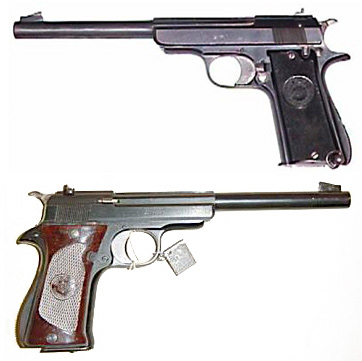
In 1932, Star introduced the I and F series pistols. Both are of similar design to their existing vest pocket types, being of fixed barrel, straight blowback design. The safety is a lever on the left side, operated in the normal manner by the thumb, but just rear of the trigger. While the Model I series was a larger defensive vest pocket pistol in .32 ACP, the Model F series was a .22 pistol intended for more general uses, such as varmint control, sport, plinking and target shooting. To the right are two model F Sport (or possibly, F Target) pistols, showing the general arrangement of features.
Three basic versions of this first model were made, each differing mostly in barrel length; a 4" sold simply as the model F, a 6" version called the F Sport and a 7" version called the F Target. The longer versions presumably had better sights, but all versions had flat checkered wood or plastic stock panels (i.e. without the thumbrest of later versions).
Special variants of the first model F series
In addition to these base models, three special variants were produced. The Model FTB was a further accurized version of one of the longer barreled pistols, imported to the US by Stoeger during 1934 only. It is not clear what "further accurized" means in this case. The FK was a single shot, non-repeating version, presumably also of the 6 or 7" gun, probably for some special target shooting purpose. The FP was a very special target version made in 1933-34 only, and added a set trigger and orthopedic grips, also probably to the 7" model.
Some of the design changes from these pistols were adopted in the second series. All these pistols were dropped by 1942, when the entire line was switched to second series production.
Second Model F Series
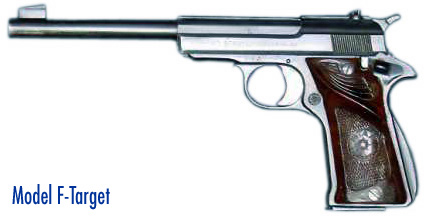
In 1942, Star updated the configuration of their small and pocket pistols to mostly have a conventional safety. Instead of being just behind the trigger, they now had more conventional looking thumb-activated safeties, pivoting about the rear of the gripframe, just rear of the hammer pin. Aside from having a generally more obvious operation, it also resembed their larger pistols, as well as the prevalent Browning High Power and Colt 1911s used by the Allies (but not most German pistols).
These pistols retained the round barrel of the original series, and adopted a simpler version of the contoured thumbrest stocks of the previously specialized FP for the entire line. All stocks seems to be made of brown plastic. The only wood stocks I have encountered are well-finished but flat panels on engraved variants, but may exist on standard production grade guns as well.
The basic lineup remained the same with the F being the 4" version, the Sport the 6" version and the Target a 7" version. All pistols seem to have had the same sights, which consisted of a micrometer adjustable rear and a replacable front blade. The shipped front sight is a triangle when inserted, flat on the back. The screw to remove is on the right side of the gun.
Olympic & Olympic Rapid Fire
The only special variant of this series was the model F Olympic. Though I have no direct confirmation of this, the features of the gun seem to indicate that it was actually designed for use in Olympic 50 meter pistol. An even more specialized version with a compensator and large counterweight/handguard was marketed as the "Model F Olympic Rapid Fire" and appears to be expressly designed for international 25 meter rapid fire pistol competition.
The caliber is main reason for this. Unlike anything else built by Star, this pistol is chambered in .22 Short, labeled as .22 Corto on the slide. This is much less powerful than Long Rifle, and there would be no other reason to do so. Most .22 caliber pistols do not function with lesser-powered loads, so it would have taken Star engineers some effort to ensure the pistol was reliable and accurate with the Short cartridge.
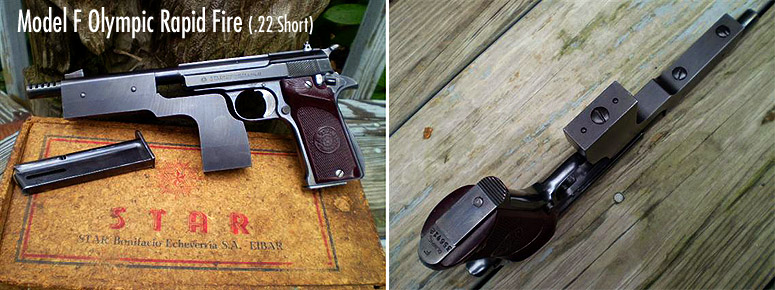
A third model F Olympic has been confirmed with an aluminum slide, which is almost certain to have been the case in this model also. Though this is a clever way to reduce weight, its certainly the only aluminum-side (or bolt) weapon I am aware of and must have taken some effort to get right. I suspect these are somewhat fragile, and should not be shot that much anymore.
This series remained in production until 1958, when it was wholly replaced with the Third Model F series.
Third Model F Series
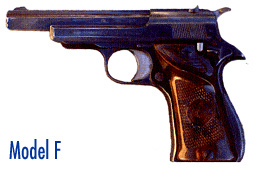
In the 1958, the overall style of the pistols was updated with a more streamlined, integrated-looking squared barrel. Small internal changes were also made, but the general layout remained the same, and most parts will interchange between the two.
Models made from 1958 onward were the usual three, the basic 4" F, the 6" F Sport and the 7" F Target with improved sights.
A small number were additionally sold under the "Starlet" name by Firearms International Corp. in the US. I believe all of these were 4" models, sold as inexpensive, general purpose "plinking" guns.
Olympic
The Olympic variant continued to be made during this series as well. I have no paperwork to indicate when or how many were made, but examples have been seen with proofmarks thru 1963.
These guns are marked as being .22 Corto in the slide, have the same profile barrel and other exterior details as the standard guns, with 6" barrels. Barrel weights were still included, as well as a selection of spare (or possibly alternative) parts. Slides are finished in some sort of epoxy coating, as opposed to just being anodized or otherwise chemically colored.
Fourth Model F Series
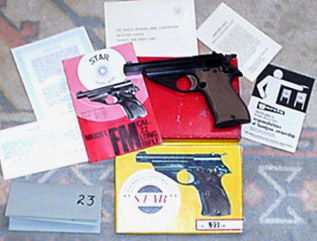
In 1967 the last series revision was instituted across the line. The major change was in the addition of an external last-shot hold open slide stop to the left side of the frame, but small contour and style changes are present on a number of parts.
The frame profile changed in a notable manner, especially along the rear of the grip. Instead of being straight along the rear of the stocks, with a pronounced, all-steel backstrap (like a Colt 1911 mainspring housing), the entire frame is the same width to the rear. Stocks are now curved along their rear face, to match the frame profile. Aside from this shape change stocks from this series are much more often plastic than wood, but of the same general profile and design.
The model name changed to FR for the 4" version, usually sold with flat (non-thumbrest) stocks. The 6" FR Sport and 7" FR Target both retained their thumbrest stocks, had a removable, replaceable undercut front sight and removable, adjustable barrel weights.
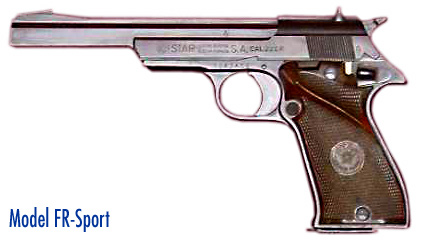
A model FM was also introduced — shown above — with more significant changes. To what end I am not sure. The most notable is a significant amount of steel in front of the trigger guard. These may have been made in several barrel lengths, and seem to have been all sold with wood stocks. The 4" models at least had the flat (no thumb rest) left side as the basic 4" model FRs.
The entire model F series went entirely out of production with Star's general cessation of classic series prodction in 1983. No Star model of .22 target or general purpose pistol ever replaced the model F series of pistols.
